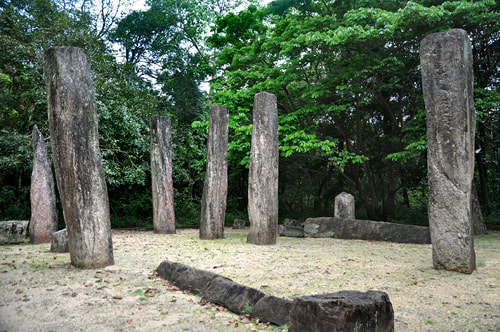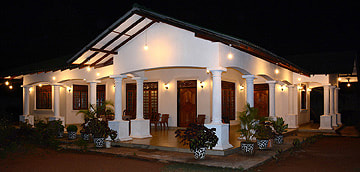 The archaeological site of Manikdena, situated near Dambulla at the northern foothills of Sri Lanka’s higlands, is better known under the spelling Menikdena. “Manik”, pronounced like “Maenik”, is the Sinhala word for gems. Actually, the plains close to Sri Lanka’s mountains are the main deposits of the island’s famous gemstones. However, the term refers to a legend. The ashes of Sri Lanka’s “last enlightened being”, the Arhat Maliyadewa, are said to have been buried in Manikdena is a casket decorated with jewels, hence the modern name of the place. The anient name “Butgama” simply means “Buddha Village” or “Buddhist settlement”. Though not far away from popular destinations of the Cultural Triangle such as Golden Temple, Lion Rock, Matale Spice Gardens, the small heritage site of Manikdena is still off the beaten path. To be honest, it’s not a must-see for first-time travellers in Sri Lanka. Nonetheless, Manikdena may be of some interest for those interested in the ancient Sinhalese civilisation, as the archaeological reserve of Manikdena represents a very common type of monastic architecture from the early Middle Ages better than any other excavation site in Sri Lanka, namely the so-called “Pabbata Vihara”. This archeological name translates to “mountain monastery” and seems to indicate something spectacular. But actually it only refers to one characteristic feature of this kind of monasteries: The major edifices were erected on a shared platform, on a slightly higher level than the surrounding residential area of the monk. The elevated ceremonial area of a Pabbata Vihara typically carried four or five buildings in a square or quincunx order, namely one or two assembly halls of the monks (at least an Uposathagara) and shrines for image-worship (Patimagara), tree-worship (Bodhigara) and relic-worship (Chaitiyagara or stupa terrace). Though this type of regular layout was quite common in the outskirts of Anuradhapura and near villages in the provinces, there are only few places, where today’s visitor can easily identify all four or five characteristic buildings. Manikdena is definitely the best place, to study the Pabbata Vihara style, which was the predominant form of monastic architecture in the late Anuradhapura period. Manikdena is managed the Archaeological Department in cooperation with one of Sri Lanka’s most famous private schools, the Trinity College in Kandy, since it has been transformed in an arboretum representing the typical vegetation of Sri Lanka’s intermediate zone.
0 Comments
Leave a Reply. |
AuthorNuwan Chinthaka Gajanayaka, Categories
All
Archives
June 2020
Buddhism A-Z
|
|
Find a list of 270 Sri Lanka travel destinations & attractions: CLICK HERE Our illustrated list of places of interest is sorted by travel regions, more precisely: by 22 most recommendable places for overnight stays. All 270 sights are within day-trip distance from one of those 22 major locations. (Please understand: Loading 270 images requires more seconds than usual.) |
Why travel with Lanka Excursions Holidays?
+ We are a local agency owned and run by Sri Lankans, not part of international holdings
+ We are well known for our direct and personal relationships with travellers
+ We facilitate authentic meetings with locals who are not from the tourism sector
+ We follow a strict policy not to push guests to visit shops and shops and shops
+ We have an unrivalled expertise to show you places off the beaten path
+ We provide genuine information instead of clichés and tourism industry slogans
+ We are a local agency owned and run by Sri Lankans, not part of international holdings
+ We are well known for our direct and personal relationships with travellers
+ We facilitate authentic meetings with locals who are not from the tourism sector
+ We follow a strict policy not to push guests to visit shops and shops and shops
+ We have an unrivalled expertise to show you places off the beaten path
+ We provide genuine information instead of clichés and tourism industry slogans
Our ambition is to provide high-quality information in preparation of your Sri Lanka holidays
... and even more superb travel experiences
... and even more superb travel experiences
we also run our own guesthouse near Anuradhapura:
First House Mihintale
87, Missaka Mawatha, Mihintale 50300, Sri Lanka.
0094 71 6097795
87, Missaka Mawatha, Mihintale 50300, Sri Lanka.
0094 71 6097795
|
Lanka Excursions Holidays
Registration Number SLTDA/SQA/TA/02179
255/24, "Green Park" Dawatagahawatta, Thimbirigaskatuwa, Mahahunupitiya East, Negombo, Sri Lanka
Office: +94 31 223 991 Hotline: +94 71 6097795 [email protected] Lanka Excursions Holidays office hours 8.00 to 6.00 p.m. daily (except from June Fullmoon Day)
|
if not stated otherwise, texts and photos provided by Ernst A. Sundermann, sales manager of Lanka Excursions Holidays
all rights reserved, © 2016 Lanka Excursion Holidays
all rights reserved, © 2016 Lanka Excursion Holidays
 RSS Feed
RSS Feed



